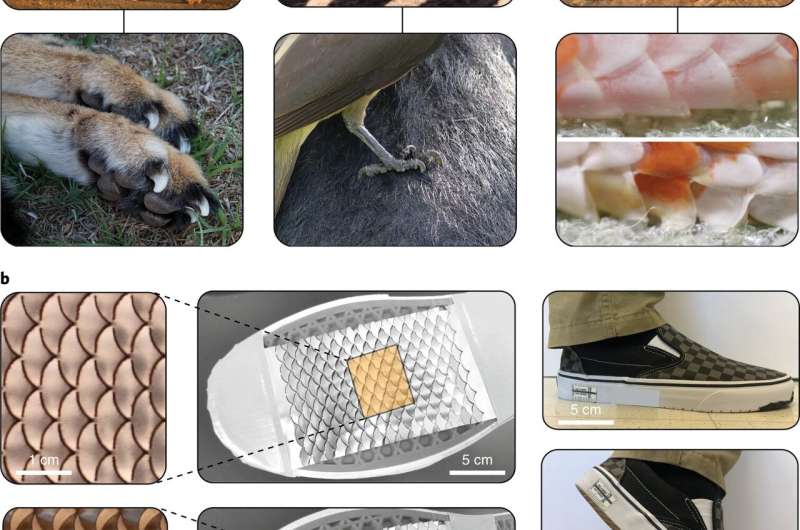Dynamic kirigami shoe grip designed to reduce risks of slips and falls

Losing your balance and falling does not just happen during icy Boston winters. The slip resistance of your shoes can determine how well you walk on different surfaces without losing balance. Shoe grips increase friction by engaging with the walking surface, helping to increase stability. In a recently published study, investigators from Brigham and Women's Hospital and the Massachusetts Institute of Technology (MIT) presented a bioinspired assistive shoe grip based on kirigami, the Japanese art of paper cutting.
Kirigami can be used to create highly flexible surfaces that buckle from a flat sheet to a three-dimensional textured surface. The new kirigami-based shoe sole is intended to reduce the risks of slips and falls by adjusting as a person steps, increasing friction with pop-up spikes as necessary. In Nature Biomedical Engineering, the team reports the results of friction testing on a range of surfaces, including ice, finding that the kirigami shoe soles increased friction with the ground to get a better grip on slippery surfaces.
"What we developed is a dynamic shoe sole that can give you grip when you need it, which is when you are actually walking and moving," said co-corresponding author Giovanni Traverso, MB, BChir, Ph.D., a gastroenterologist and biomedical engineer in the Division of Gastroenterology at the Brigham and MIT. "The key is that it is dynamic and has the capacity to tune friction as you take a step. Current solutions like cleats have spikes that are always present, so a dynamic shoe grip that could adjust itself with movement would be a more ideal way to mitigate falling."
To learn more about dynamic ways of modulating friction, the researchers looked to nature for inspiration, examining how animals have scales or claws that selectively increase friction in certain situations. They recognized that by applying change in the shape of the sole, they could control the popping up of the spikes and modulate friction with the surface due to the flexible, buckling nature of kirigami. To identify the set of shapes that would best accomplish this, the team modeled each shape's performance on how it popped up under certain strains.
The buckling-induced kirigami patches were constructed using steel and attached to shoe soles, enabling the dynamic tuning of the walking surface's frictional properties. Traverso and colleagues tested the soles by creating flat or popped-up versions and measured the friction on different surfaces including ice, vinyl and hardwood to identify the optimal conformation. They initially tested the pop-up designs in the form of a sheet that was dragged across different surfaces. Then the team tested the designs on three human subjects by placing the sheets on shoe soles and having the subjects walk on a block of ice that was placed on a surface that measured the amount of force. By having the subjects walk on the ice both with and without the soles, the team could get a sense of the mechanics behind the design.
The results showed that the kirigami shoe grips were able to enhance the frictional properties between the soles and the walking surface, mitigating slips and falls. The team reports that use of the kirigami shoe grip could achieve a greater friction than that observed with standard winter boots by two- to three-fold. Although the initial designs were constructed using stainless steel for proof of concept, the researchers are now applying the concept to other materials that are more commonly used today. They are also focusing on creating prototypes where the grip is already built into the shoe as opposed to being added on.
"We are now working towards applying and incorporating the grips into different shoes," said Traverso. "The grips could be useful in the sporting shoe industry, in standard shoes used in day-to-day settings, and in occupational health situations where there might be an increased risk of slippage."
More information: Sahab Babaee et al, Bioinspired kirigami metasurfaces as assistive shoe grips, Nature Biomedical Engineering (2020). DOI: 10.1038/s41551-020-0564-3


















